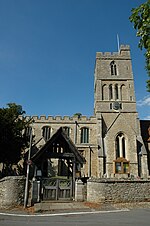Sharnbrook railway station

Sharnbrook railway station was opened in 1857 by the Midland Railway to serve the village of Sharnbrook in Bedfordshire, England. It was on the Midland's extension from Leicester to Bedford and Hitchin. It was situated near to Sharnbrook Summit. Here, originally there was a 1 in 119 gradient from the south taking the line to 340 feet above sea level. Around 1880, the line was quadrupled, with the new goods tracks taken through 1,800 yd (1,600 m) long Sharnbrook Tunnel. Following this, in 1884, a long curve, the Wymington Deviation allowed the ruling gradient on the slow/goods lines to be reduced to 1 in 200.It closed in 1960 and the station buildings were subsequently demolished. The slow/goods lines were singled and put up to passenger standard in 1987. As of 2007 they see one train a day plus occasional engineering diversions, such as on the weekend 6/7 May 2007. Quadruple track was restored between Sharnbrook Junction and Kettering South Junction in 2020; electrification was in progress as at September, 2020. The existing Down Slow remains signalled for bi-directional use; the Up Slow is signalled for use in that direction only.
Excerpt from the Wikipedia article Sharnbrook railway station (License: CC BY-SA 3.0, Authors, Images).Sharnbrook railway station
Calle Benedictinas de San José, Burgos San Pedro de la Fuente
Geographical coordinates (GPS) Address Nearby Places Show on map
Geographical coordinates (GPS)
| Latitude | Longitude |
|---|---|
| N 52.2254 ° | E -0.5318 ° |
Address
Iglesia de San Pedro de la Fuente
Calle Benedictinas de San José 13
09003 Burgos, San Pedro de la Fuente
Castilla y León, España
Open on Google Maps





